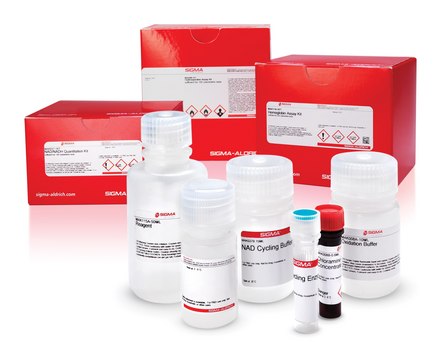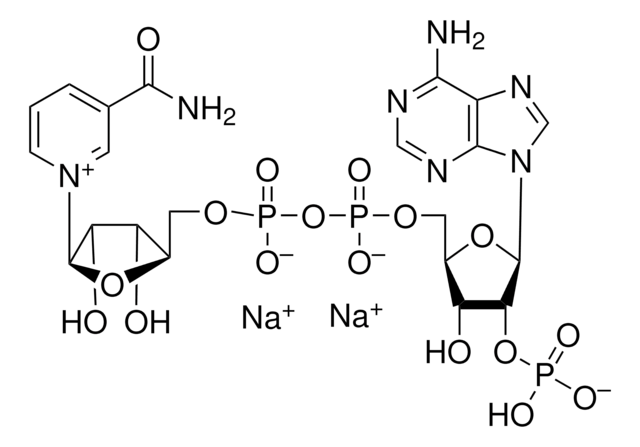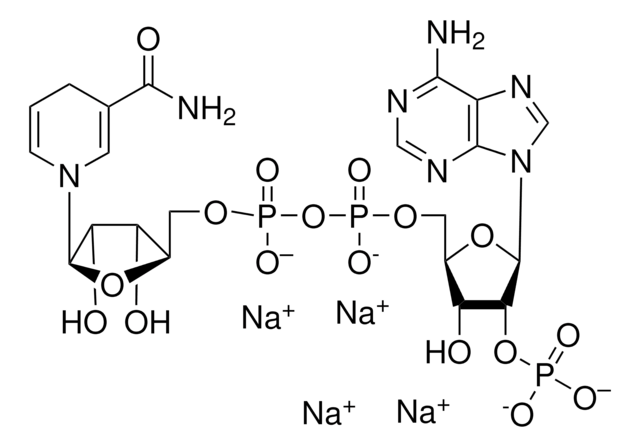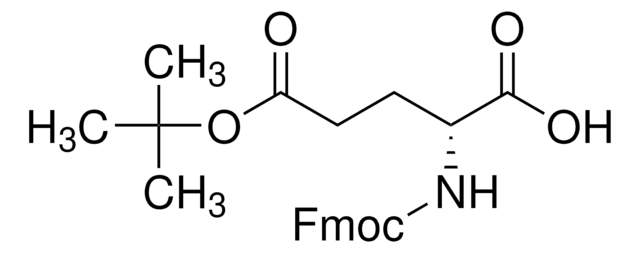MAK216
High Sensitivity NADPH Assay Kit
Sufficient for 100 Fluorometric tests
Synonym(s):
NADPH Quantitation Kit
Sign Into View Organizational & Contract Pricing
All Photos(2)
About This Item
UNSPSC Code:
12352200
NACRES:
NA.84
Recommended Products
detection method
fluorometric
storage temp.
−20°C
General description
The reduced form of nicotinamide dinucleotide (NADPH) functions as the cofactor for many redox enzymes and contributes to reductive biosynthetic pathways. NADPH is mainly produced from glucose through the oxidative pentose phosphate pathway.
Application
High Sensitivity NADPH Assay Kit has been used to determine the intracellular NAD(P)H and NAD(P)+ levels.
Suitability
Suitable for the detection of NADPH in a variety of biological samples such as cell and tissue culture supernatants and purified mitochondria.
Principle
The High Sensitivity NADPH Quantification Fluorometric Assay Kit is suitable for quantifying NADPH (ranging from 2-10 pmole/well) in tissues, cells, and mitochondria. The kit detects intracellular NAPDH in the enzyme recycling reaction and does not require purified NADPH from the samples. NADPH is determined by measuring a fluorescent product (λex = 535/ λem = 587 nm) proportional to the amount of NADPH present.
Kit Components Only
Product No.
Description
- NADPH Extraction Buffer
- NADPH Cycling Buffer
- High-Sensitivity Probe
- NADPH Cycling Enzyme Mix
- NADPH Standard
Hazard Statements
Precautionary Statements
Hazard Classifications
Aquatic Chronic 3
Storage Class Code
10 - Combustible liquids
WGK
WGK 3
Choose from one of the most recent versions:
Certificates of Analysis (COA)
Lot/Batch Number
Don't see the Right Version?
If you require a particular version, you can look up a specific certificate by the Lot or Batch number.
Already Own This Product?
Find documentation for the products that you have recently purchased in the Document Library.
Junjun Wu et al.
Metabolic engineering, 53, 1-13 (2019-01-27)
Medium-chain (C6-C10) chemicals are important components of fuels, commodities and fine chemicals. Numerous exciting achievements have proven reversed β-oxidation cycle as a promising platform to synthesize these chemicals. However, under native central carbon metabolism, energetic and redox constraints limit the
Mahmoud A Bassal et al.
Nature communications, 13(1), 2614-2614 (2022-05-14)
The interaction of germline variation and somatic cancer driver mutations is under-investigated. Here we describe the genomic mitochondrial landscape in adult acute myeloid leukaemia (AML) and show that rare variants affecting the nuclear- and mitochondrially-encoded complex I genes show near-mutual
Junjun Wu et al.
Metabolic engineering, 44, 313-324 (2017-11-11)
Previous studies have made many exciting achievements on pushing the functional reversal of beta-oxidation cycle (r-BOX) to more widespread adoption for synthesis of a wide variety of fuels and chemicals. However, the redox cofactor requirement for the efficient operation of
Nilson Carlos Ferreira Junior et al.
Cells, 10(8) (2021-08-28)
We used mouse microglial cells in culture activated by lipopolysaccharide (LPS) or α-synuclein amyloid aggregates (αSa) to study the anti-inflammatory effects of COL-3, a tetracycline derivative without antimicrobial activity. Under LPS or αSa stimulation, COL-3 (10, 20 µM) efficiently repressed
Mauricio Dos-Santos-Pereira et al.
Glia, 68(3), 561-573 (2019-10-28)
We used mouse microglial cells in culture activated by lipopolysaccharide (LPS, 10 ng/ml) to study the anti-inflammatory potential of cannabidiol (CBD), the major nonpsychoactive component of cannabis. Under LPS stimulation, CBD (1-10 μM) potently inhibited the release of prototypical proinflammatory
Our team of scientists has experience in all areas of research including Life Science, Material Science, Chemical Synthesis, Chromatography, Analytical and many others.
Contact Technical Service



